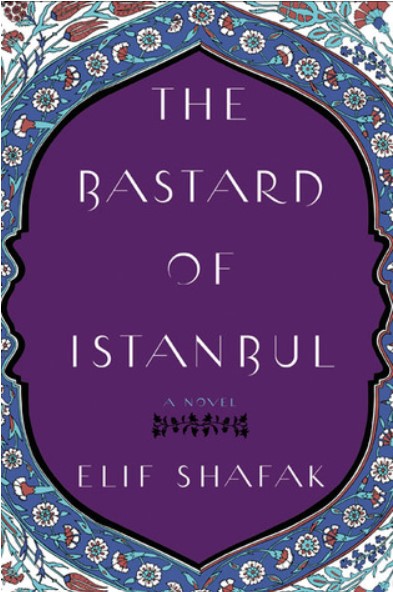The Bastard of Istanbul by Elif Shafak
Review by Michael Attard
The Bastard of Istanbul, by Elif Shafak, is a complicated novel which, through the lens of historical hostilities between Turks and Armenians, tells the story of people conflicted by the burden of reconciling the past with the present. They must choose to accept or reject an inherited angst within themselves which strikes at their existential nature.
It is difficult to clearly determine who the main character is. But the actual “bastard” of Istanbul is Asya, a 19-year-old Turkish woman living in that city with five other women: her grandmother and four other women whom she calls “Auntie.” However, one of the four aunts is her birth mother. Asya is a self-proclaimed nihilist. Rejecting moral righteousness and believing that existence is meaningless, she has attempted suicide and written her own nihilistic principles. Perhaps because her mother had originally planned to abort her, she was predetermined as a non-pertinent being while in the womb, and this carried forward to life.
Armanoush is also a 19-year-old woman, and her ethnic background is Armenian-American. It is her father who is Armenian. His family, which long ago fled Turkey, ensures that she is aware of the Turkish genocide against the Armenians in 1915. Her paternal grandmother and her father’s three sisters are key figures in her life. Her father’s family lives with the past and fears for Armanoush. They did not want her “to stand out” or “to shine too bright.” “Writers, poets, artists, intellectuals were the first ones within the Armenian milleu to be eliminated by the Ottomans.” Family dynamics lead her to feel that “something was absent.” She had to go there, to Turkey, “to find her Armenianness.”
Interestingly, the author has linked these two young women through Armanoush’s mother’s second marriage to a Turk. It is her stepfather’s family that she visits in Istanbul, which happens to include Asya and the four aunts. Her stepfather, Mustafa, is of course their brother whom they have not seen for twenty years.
There is plenty for the reader to keep track of, but the underlying current remains consistent: Turkish denial of genocide against the Armenians versus the Armenian inherited pain. Common to both sides is a resentment of the other. The Armenians exhibit an inability to stop thinking about the past and suffer bitter indignation at having been treated unfairly. The Turks resent this insistence upon connecting them to perpetrators of evil from a perceived ancient time.
The dreariness of the story is encased in the writer’s ability to transfer the macro-historical perspective into the personal. It seems that the question of who Asya’s father is will never be answered, but eventually it is, and truth only exacerbates the shame. Historical shame morphs into individual ignominy.
Asya’s multitudinous thoughts play out through characters she often encounters in “a small coffee shop on a narrow, snaky street on the European side of Istanbul.” Here, nihilists, pessimists, and anarchists shared their penchant for lethargy. Asya expressed her belief that the past was a “shackle.” Her lover counters that, “Everybody needs a past.” And thus, the ability to live meaningfully is no further understood.
From the perspective of the injured party – historically the Armenians, and personally Armanoush’s family – there is the desire for recompense. This theme is created, developed, and carried to a conclusion through a piece of jewelry, “a graceful brooch in the shape of a pomegranate, delicately smothered with gold threads … with seeds of rubies glowing.” Once stolen, it was returned 90 years later by a Turkish aunt to an Armenian niece.

It is this act of returning the brooch, never actually completed, which illustrates not only the theme of recompense but initiates the acknowledgement that retribution is due and cannot be escaped. It is the clairvoyant Turkish aunt who pierces into the dark of a hidden, egregious act and presents the most culpable with a choice. They can remain inert in ignorance or walk out of both the past and the future at once.
There is a sudden death and yet the story is less bleak. Asya’s mother is drinking tea from a fragile glass that she had bought twenty years ago. She is surprised when she realizes that the delicate glass has lasted this long. She did not know that it could “survive.”
Intrinsic to the story is the author’s writing ability. She shows us who the characters are through her vivid description of their physical features, the way they dress, and how they smoke cigarettes. More profoundly, the writing portrays how others comprehend the main characters. In reference to Asya’s mother, the reader can feel “the gaze of all the men who stared,” and how “the vendors looked disapprovingly at her shiny nose ring … deviance … the sign of lustfulness.”
At times, I felt that the description diminished the story. The long lists of Turkish and Armenian food became tedious. More baffling were segues that went on for a few pages. We are introduced to a young man who goes on a date with Armanoush. It appears that the reader is meeting a significant character but then he fizzles away like the date. This episode and others like it detracted from and slowed the story down.
Ultimately, the book is not easy to read, and the historical political background will only appeal to a certain audience. However, the author’s examination of how individuals through the past come to be the people they are is a method by which we can all better understand our personal histories.
The Reviewer
Michael Attard is a Canadian who has lived in Gwangju since 2004. Though officially retired, he still teaches a few private English classes. He enjoys reading all kinds of books and writes for fun. When the weather is nice, you may find him on a hiking trail.
Featured image by Seema Miah on Unsplash







